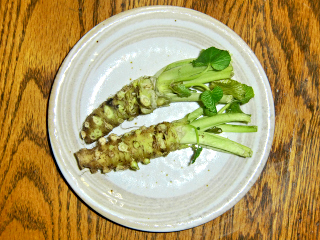Nothing magical, all about passion
(and a little bit of fun)!

(photo courtesy of Saké Restaurant)
Recently opening in the revitalised Hamer Hall (part of Arts Centre in Melbourne), Saké Restaurant & Bar serves up fine contemporary Japanese cuisine alongside a spectacular list of sake. With their first restaurant in Sydney winning the Sydney Morning Herald Good Food Guide Chef’s Hat Award each year, Saké is definitely one to check out!
This time, we are honoured to have an interview with Wayne Shennen, the dedicated sake-lover and talented bar manager from Sydney.

About Sake and Food Pairing
— Could you please tell us more about your background in regards to bartending?
I’ve been a bartender for 10 years. The alcohol side of things is interesting for me, but flavours and combinations are a lot of fun so I especially love cocktails. I regularly go to Japan, and sake as a product has always intrigued me, so it’s great to be able to indulge my interests there with my job.
— When was your first sake experience and what was your impression?
I think I’m like most people, in that my first experience with sake was pretty bad. I had hot sake at many restaurants and they must have all been pretty low grade. The flavours were very strong, without any subtlety.

— Why do you like it so much now?
The turning point was when I was in Japan in 2006 to teach English. I’d heard some good things about sake and thought to myself, “Ok, one last chance.” I went to a little bottle shop and asked for something nice, and I think they gave me a little bottle of daiginjo because it was very floral from memory. I remember thinking “so that’s how sake is supposed to taste!” That is when I started drinking sake again.
— How is sake doing in Australia at the moment?
It’s just booming and everyone in Sydney is interested. But I think there is a parallel between what sake is going through in Australia at the moment and what tequila went through 5 years ago.
Just like how it’s the cheap, strong tasting product that come to mind for many people when talking about tequila, lots of people are afraid of sake because of incorrect associations. Most Australians seem to think sake is very strong and very dangerous from a hangover point of view, and it’s just not true.

— Do you think it’s possible to turn the situation around?
It’s a complicated process because it requires a change in mentality, but one of the things we do is to position sake as a substitute for wine in Saké Restaurant. We always serve sake in beautiful stem-less glasses to capture the aromas, and also because many customers will down the whole thing if you give them ochoko (shot glasses).
Sake can be such a pleasant product, but for many people the first experience with sake was like mine. With this in mind when I talk to patrons and they say “I don’t like sake” or “Wayne, you show us”, I look to reassure them, and almost always the response is “that was not what I was expecting!” I get a lot of job satisfaction from this.

— What are some of your favourite sake?
One of my favourites would be the organic sake we sell here from Kozaemon Brewery. It’s a junmai ginjo made from Miyamanishiki rice. Another one would be from Amabuki Brewery. It’s made using strawberry flower (Saganohana Ichigo) yeast. It smells like nashi pear, vanilla and cinnamon, and has a nice finish. It’s very tasty and great as an aperitif.
With food, the Yuho Junmai Ginjo 55 is spectacular. It’s been aged for two years and it’s got these amazing toffeed banana characteristics that complement the bigger dishes to perfection.
Depending on the day, I quite like the yamahai version of the organic sake I have mentioned too. It’s punchier and just a little more robust.

— Which are some of your favourite sake matching dishes on the menu at Sake Restaurant?
It would be the tuna ceviche. It’s a crossover of the Japanese and the Central/South American style, in which the combination of flavours are just amazing (yuzu, umami from soy, baby coriander, jalapeno chilli and the raw tuna)! I match this with the organic sake from Kozaemon.
Another is the prawn dumplings and the Tokubetsu Junmai from Kozaemon. It works amazingly well.
— How do you match sake for your customers?
I usually match sake with the dishes that customers have ordered so I will first ask them if they would like to try sake. I honestly think that nothing works better with our food. For example, there are sake that work very well with sashimi and others not so much, so we will talk to customers and explain to them why they should try this product instead of that at this stage of the meal.
For customers who ask for dessert wine or a glass of port, I will ask if they would like to try some new alternatives, like Kokuto Umeshu. The Kozaemon Junmai Umeshu is another way to give people something new that they might not have known existed.

— How do you know what to recommend to your customers?
What I tend to do is to start off with light honjozo daiginjo because I think it’s very accessible if patrons have never had sake before. But if they have had sake before I might recommend Kozaemon Junmai Ginjo Bizen Omachi from our sake list, which is also very accessible and matches really well with sashimi.
Depending how the customer enjoys the first sake and the matching, I’ll recommend something from there.
— How do you balance the rather delicate sake with other ingredients in a cocktail?
Most of the sake that we sell in the restaurant is so delicate, so good that it’s difficult to add something to it to make it taste better. What I tend to use in sake cocktails are the lower grade sake we sell, or the aged stuff.
For example there’s one cocktail called the Tasty Budo which uses a 3 year junmai, because it is robust enough thanks to the ageing process that it can handle being mixed with other flavours. Recently I’ve been playing around with some of the more delicate product in Martini style drinks, trying to coax out subtle combinations without overpowering the original freshness of the sake. It’s difficult, but fun!

Yuzu Sour – served on the rocks
Yamazaki 12yo, Johnny Walker Black, yuzu, lemon & strawberry
— Do your customers like to have sake neat or in cocktails?
For sake I recommend straight, for cocktails I say ‘why not try something new?’ For example, if someone asks for a Cosmopolitan I’ll suggest they try something that they can only get Saké Restaurant & Bar, like one of our originals called Black Zacquiri (Ron Zacapa 23yo rum, Choya Kokoto Umeshu & fresh lime) or the Yuzu Sour (Yamazaki 12yo, Johnny Walker Black, yuzu & strawberry).
— How did you come up with creative names of your cocktails?
Out of boredom. (Laughs)
For example Rose Miss Wednesday is named after Neferutari Bibi, a.k.a. “Miss Wednesday”, a character from the very popular Manga “One Piece“.
I have some knowledge of the Japanese history, especially when it is related to martial arts, and I’ve drawn on that a few times. I have a ‘Man-tini’ range of drinks that start with the pre-dinner Nobunaga*. I’ve finished the recipe for the Toyotomi* and it’s been very well received, while the Tokugawa* is a work in progress. They are based on old school gentlemen style cocktails with stronger and more aggressive flavours.
* Three famous warlords during the Sengoku period

— Wow, you are very familiar with the Japanese history! What do you think of Japan?
I lived for a year and a half in Saitama to teach English and I absolutely love Japan! I’m from a fairly small town in New Zealand and Japan is interestingly different to me. Everywhere you go there is an opportunity to learn something new and exciting.
— Have you been to a sake brewery in Japan before?
Before my last trip to Japan the only brewery I’d been to was in the middle of Kyushu during summer, and the son of the president showed me around for 4 hours! It was really comprehensive and interesting.

— Do you speak Japanese?
Not as much as I should, so I keep studying. Much of my Japanese is martial arts based because I train in jujutsu, and I’m great at talking about the weather, but I can read the kanji (chinese characters) on the sake labels and that sure helps at stocktake time!
— Please give some advice to first time sake drinkers.
I think good sake has an amazing balance of acids and umami that you can’t help but like. Start off with the more accessible ones, the sweeter and smoother ones. If they ever start to become boring, you’re ready for something more complex.
*** STAY TUNED! Wayne is going to tell us more about his professional sake course in Chicago and his Japan tour next time! ***


~~~~~~~~~~~~~~~~~~~~~~~~~~~~~
 |
Wayne Shennen According to Wayne Shennen, good bartending is all about balancing flavours. “The subtlety of each ingredient should shine through,” explains the passionate New Zealander, a trained sake sommelier and one of Sydney’s most respected bartenders at award-winning Saké Restaurant & Bar. “If you can taste what you’re drinking, you tend to treat alcohol with more respect.”a |

Saké Restaurant & Bar
Hamer Hall, Arts Centre Melbourne, 100 St Kilda Rd, Melbourne VIC 3004.
Tel: +61 (3) 8687 0775
www.sakerestaurant.com.au/melbourne
Lunch
Mon – Sun 12.00 – 3.00pm
Dinner
Mon – Thurs 6.00 – 10.30pm
Fri 6.00 – 12.00am
Sat 5.30 – 11.30pm
Sun 5.00 – 10.00pm
Related articles:
The Sake Alchemist #2
The Sake Alchemist #1
Tasting Business at Saké Restaurant & Bar




